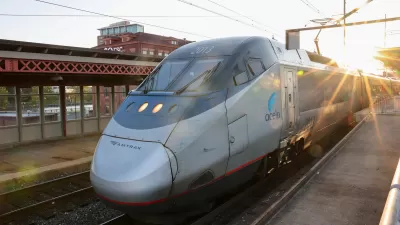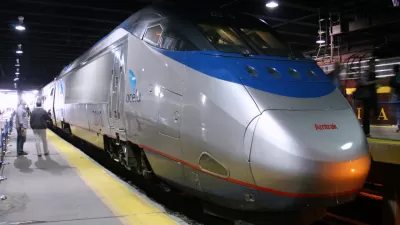Burgess Everett and Adam Snider look at the growing debate over where to allocate limited high-speed rail funds: on the East Coast, where rail already has a foothold, or out West, where California has the land and starter funds to make it happen.
Seen as a "shining savior" to those looking to reduce congestion and efficiently move millions of people, the contruction of high-speed rail throughout the United States (as President Obama had hoped) is being contrained by geography and limited funds. As such, HSR supporters are enmeshed in a debate over where to focus limited resources.
According to Everett and Snider, "lawmakers are torn between how to use limited funds: along the densely
packed East Coast, which has a history of commuter rail, or out West,
where California has ponied up billions of dollars to build a high-speed
system, much of it from scratch."
California has a head start, with $6 billion already allocated to the first phase of their HSR project, which could break ground this year. However, California's push is facing challenges at home and in D.C.
"In Washington, freshman Rep. Jeff Denham (R-Calif.), a member of the
House Transportation and Infrastructure Committee, has pushed to
concentrate high-speed rail efforts in the Northeast, not back home.
"I've looked deep into California high-speed rail, and they continue
to change the number, and it doesn't pencil out. There's a lot of
hypothetical numbers - you can build a better business plan somewhere
like the Northeast [Corridor], where you've already got ridership
numbers and current travel times," he said.
FULL STORY: High-speed rail's competing visions

Maui's Vacation Rental Debate Turns Ugly
Verbal attacks, misinformation campaigns and fistfights plague a high-stakes debate to convert thousands of vacation rentals into long-term housing.

Planetizen Federal Action Tracker
A weekly monitor of how Trump’s orders and actions are impacting planners and planning in America.

In Urban Planning, AI Prompting Could be the New Design Thinking
Creativity has long been key to great urban design. What if we see AI as our new creative partner?

Massachusetts Budget Helps Close MBTA Budget Gap
The budget signed by Gov. Maura Healey includes $470 million in MBTA funding for the next fiscal year.

Milwaukee Launches Vision Zero Plan
Seven years after the city signed its Complete Streets Policy, the city is doubling down on its efforts to eliminate traffic deaths.

Portland Raises Parking Fees to Pay for Street Maintenance
The city is struggling to bridge a massive budget gap at the Bureau of Transportation, which largely depleted its reserves during the Civd-19 pandemic.
Urban Design for Planners 1: Software Tools
This six-course series explores essential urban design concepts using open source software and equips planners with the tools they need to participate fully in the urban design process.
Planning for Universal Design
Learn the tools for implementing Universal Design in planning regulations.
Gallatin County Department of Planning & Community Development
Heyer Gruel & Associates PA
JM Goldson LLC
City of Camden Redevelopment Agency
City of Astoria
Transportation Research & Education Center (TREC) at Portland State University
Jefferson Parish Government
Camden Redevelopment Agency
City of Claremont




























